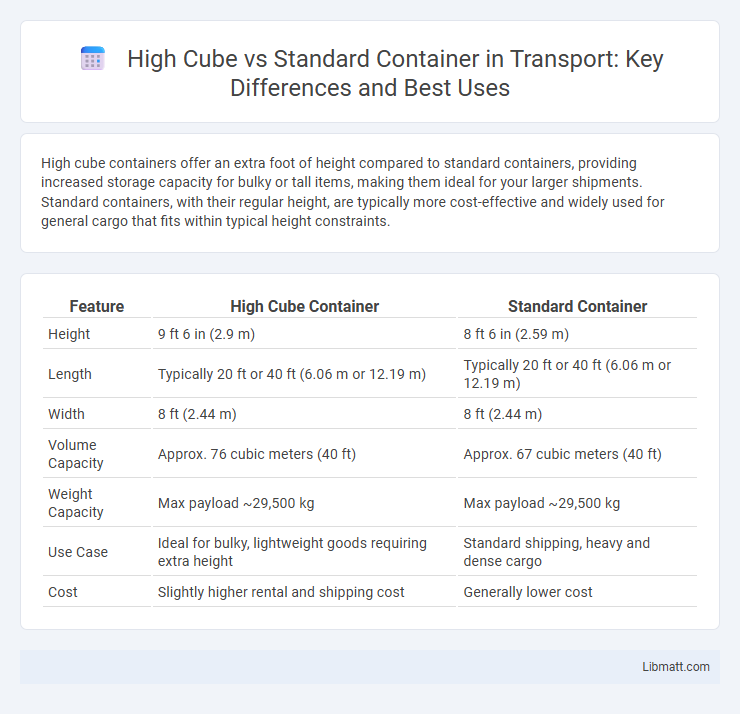High cube containers offer an extra foot of height compared to standard containers, providing increased storage capacity for bulky or tall items, making them ideal for your larger shipments. Standard containers, with their regular height, are typically more cost-effective and widely used for general cargo that fits within typical height constraints.
Table of Comparison
| Feature | High Cube Container | Standard Container |
|---|---|---|
| Height | 9 ft 6 in (2.9 m) | 8 ft 6 in (2.59 m) |
| Length | Typically 20 ft or 40 ft (6.06 m or 12.19 m) | Typically 20 ft or 40 ft (6.06 m or 12.19 m) |
| Width | 8 ft (2.44 m) | 8 ft (2.44 m) |
| Volume Capacity | Approx. 76 cubic meters (40 ft) | Approx. 67 cubic meters (40 ft) |
| Weight Capacity | Max payload ~29,500 kg | Max payload ~29,500 kg |
| Use Case | Ideal for bulky, lightweight goods requiring extra height | Standard shipping, heavy and dense cargo |
| Cost | Slightly higher rental and shipping cost | Generally lower cost |
Introduction to Shipping Containers
High cube containers offer an extra foot of height compared to standard containers, measuring 9 feet 6 inches versus 8 feet 6 inches, providing approximately 12% more internal volume ideal for bulky cargo. Standard containers, typically 20 or 40 feet long, are widely used in global shipping for their versatility and compatibility with most transport infrastructure. Choosing between high cube and standard depends on cargo dimensions, shipping cost efficiency, and loading requirements.
What is a Standard Container?
A standard container, commonly measuring 20 or 40 feet in length with a height of 8 feet 6 inches, serves as the baseline for global shipping and cargo transport. Designed for efficient stacking and compatibility with various transport modes, standard containers maximize cargo volume within international shipping regulations. Their widespread use across industries ensures reliable, secure, and cost-effective movement of goods worldwide.
What is a High Cube Container?
A High Cube container is a type of shipping container that offers an additional height of approximately one foot compared to standard containers, measuring 9 feet 6 inches tall instead of 8 feet 6 inches. This extra height provides about 12% more internal volume, making High Cube containers ideal for transporting lightweight, bulky goods or maximizing cargo space. Commonly used in international shipping and logistics, High Cube containers come in standard lengths of 20 and 40 feet.
Key Dimensions: High Cube vs Standard Container
High Cube containers offer an interior height of 9 feet 6 inches, which is one foot taller than the standard container's 8 feet 6 inches, providing approximately 12% more usable volume for cargo. While both container types typically measure 20 or 40 feet in length and 8 feet in width, the extra height of High Cube containers accommodates taller or bulkier goods, optimizing loading efficiency. The increased cubic capacity enhances shipping versatility, making High Cube containers ideal for goods requiring additional vertical space without altering the floor footprint.
Capacity Comparison
High cube containers provide approximately 12% more internal volume than standard containers, measuring 9 feet 6 inches in height compared to the standard 8 feet 6 inches. This increased height allows for greater stacking of goods without increasing the container's footprint, making them ideal for lightweight, voluminous cargo. The extra capacity typically translates to about 1,000 cubic feet more space in a high cube container, enhancing shipping efficiency and cost-effectiveness.
Weight Limitations and Load Considerations
High cube containers typically have a similar maximum gross weight to standard containers, usually around 30,480 kg (67,200 lbs), but their increased volume allows for more lightweight, bulky cargo. Weight limitations must be carefully considered to avoid overloading, especially since the extra height does not increase structural weight capacity. Your cargo planning should optimize volume without exceeding weight restrictions to ensure safe transport and compliance with shipping regulations.
Cost Differences Between High Cube and Standard Containers
High cube containers typically cost 10-15% more than standard containers due to their increased height and additional capacity, which provides approximately 12% more volume. The price difference also reflects higher shipping and handling costs, as the taller dimensions may incur extra fees in certain transport modes. Businesses must weigh the benefit of extra cargo space against these increased costs to determine the most economical choice for their shipping needs.
Ideal Uses for Each Container Type
High cube containers, offering an extra foot of height compared to standard containers, are ideal for transporting lightweight, voluminous goods such as furniture, electronics, and bulk textiles. Standard containers, with their consistent dimensions, suit dense, heavy cargo like machinery, building materials, and pallets of canned goods where height is less critical. Choosing between high cube and standard containers depends on optimizing cargo space and weight distribution for cost-effective shipping.
Pros and Cons: High Cube vs Standard
High Cube containers offer 12 inches more height than Standard containers, allowing for increased cargo volume and accommodating larger items, making them ideal for bulky shipments. However, High Cube units may incur higher shipping costs and face limited availability at certain ports compared to Standard containers, which are more widely accepted and easier to handle. Standard containers provide a cost-effective solution with universal compatibility but may restrict load capacity due to their lower height.
Choosing the Right Container for Your Needs
High cube containers offer an extra foot of height compared to standard containers, providing approximately 76 cubic feet more storage space, making them ideal for bulky or tall items. Standard containers are typically more cost-effective and suitable for general cargo with standard height requirements. Assess your cargo dimensions and volume carefully to ensure you choose the right container that maximizes your shipping efficiency and meets your budget constraints.
high cube vs standard container Infographic

 libmatt.com
libmatt.com